Analysis of Oscar Wilde's The Picture of Dorian Gray
VerifiedAdded on 2022/10/11
|7
|1941
|14
Essay
AI Summary
This essay provides a critical analysis of the mysterious transformation experienced by Dorian Gray in Oscar Wilde's novel, 'The Picture of Dorian Gray.' The essay delves into the central premise of the novel, where the protagonist ceases to age, and examines the cause of this transformation, exploring whether it is a physical or psychological process. It argues that the transformation can be seen as a psychological coping mechanism, a refusal to accept the reality of aging and decay, and a desire to maintain youthful beauty. The essay explores themes of appearance versus reality, the role of the portrait, and the influence of Gothic fiction, along with the use of secondary academic sources to support its claims. The analysis examines how the transformation is integral to the plot, linking various incidents and highlighting themes such as aging, wish-fulfillment, love, betrayal, and guilt, ultimately concluding that the transformation is a complex element of the novel.
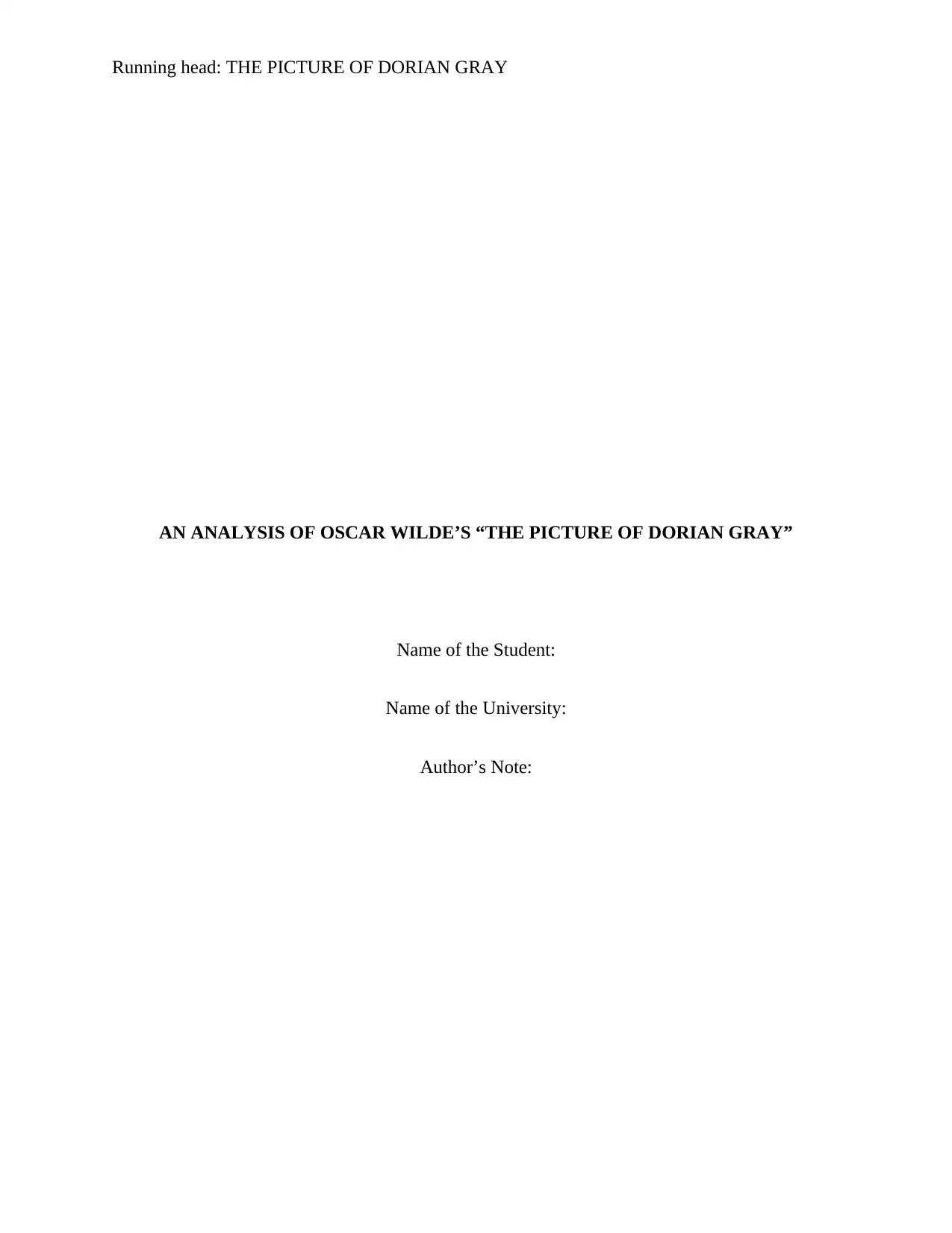
Running head: THE PICTURE OF DORIAN GRAY
AN ANALYSIS OF OSCAR WILDE’S “THE PICTURE OF DORIAN GRAY”
Name of the Student:
Name of the University:
Author’s Note:
AN ANALYSIS OF OSCAR WILDE’S “THE PICTURE OF DORIAN GRAY”
Name of the Student:
Name of the University:
Author’s Note:
Paraphrase This Document
Need a fresh take? Get an instant paraphrase of this document with our AI Paraphraser
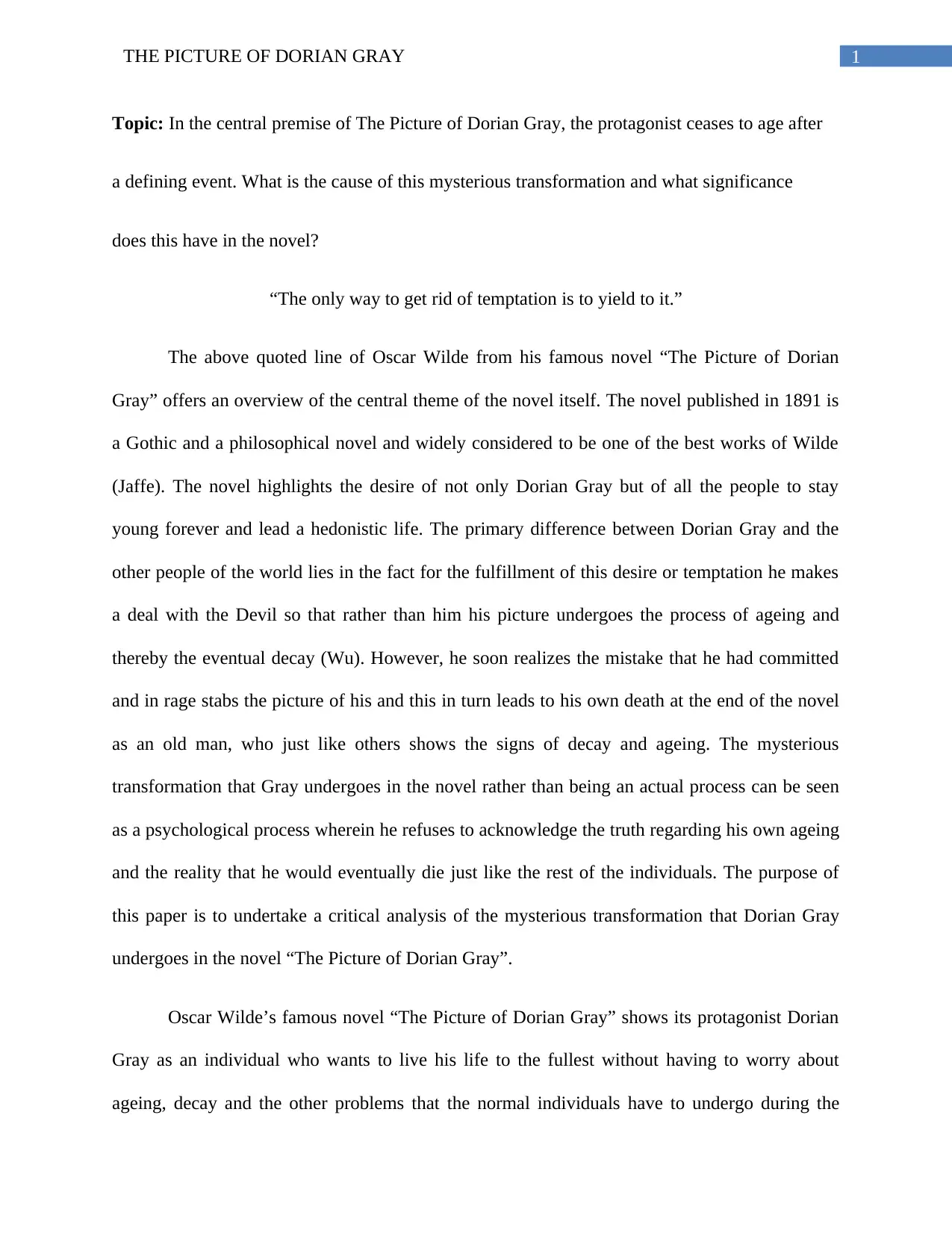
1THE PICTURE OF DORIAN GRAY
Topic: In the central premise of The Picture of Dorian Gray, the protagonist ceases to age after
a defining event. What is the cause of this mysterious transformation and what significance
does this have in the novel?
“The only way to get rid of temptation is to yield to it.”
The above quoted line of Oscar Wilde from his famous novel “The Picture of Dorian
Gray” offers an overview of the central theme of the novel itself. The novel published in 1891 is
a Gothic and a philosophical novel and widely considered to be one of the best works of Wilde
(Jaffe). The novel highlights the desire of not only Dorian Gray but of all the people to stay
young forever and lead a hedonistic life. The primary difference between Dorian Gray and the
other people of the world lies in the fact for the fulfillment of this desire or temptation he makes
a deal with the Devil so that rather than him his picture undergoes the process of ageing and
thereby the eventual decay (Wu). However, he soon realizes the mistake that he had committed
and in rage stabs the picture of his and this in turn leads to his own death at the end of the novel
as an old man, who just like others shows the signs of decay and ageing. The mysterious
transformation that Gray undergoes in the novel rather than being an actual process can be seen
as a psychological process wherein he refuses to acknowledge the truth regarding his own ageing
and the reality that he would eventually die just like the rest of the individuals. The purpose of
this paper is to undertake a critical analysis of the mysterious transformation that Dorian Gray
undergoes in the novel “The Picture of Dorian Gray”.
Oscar Wilde’s famous novel “The Picture of Dorian Gray” shows its protagonist Dorian
Gray as an individual who wants to live his life to the fullest without having to worry about
ageing, decay and the other problems that the normal individuals have to undergo during the
Topic: In the central premise of The Picture of Dorian Gray, the protagonist ceases to age after
a defining event. What is the cause of this mysterious transformation and what significance
does this have in the novel?
“The only way to get rid of temptation is to yield to it.”
The above quoted line of Oscar Wilde from his famous novel “The Picture of Dorian
Gray” offers an overview of the central theme of the novel itself. The novel published in 1891 is
a Gothic and a philosophical novel and widely considered to be one of the best works of Wilde
(Jaffe). The novel highlights the desire of not only Dorian Gray but of all the people to stay
young forever and lead a hedonistic life. The primary difference between Dorian Gray and the
other people of the world lies in the fact for the fulfillment of this desire or temptation he makes
a deal with the Devil so that rather than him his picture undergoes the process of ageing and
thereby the eventual decay (Wu). However, he soon realizes the mistake that he had committed
and in rage stabs the picture of his and this in turn leads to his own death at the end of the novel
as an old man, who just like others shows the signs of decay and ageing. The mysterious
transformation that Gray undergoes in the novel rather than being an actual process can be seen
as a psychological process wherein he refuses to acknowledge the truth regarding his own ageing
and the reality that he would eventually die just like the rest of the individuals. The purpose of
this paper is to undertake a critical analysis of the mysterious transformation that Dorian Gray
undergoes in the novel “The Picture of Dorian Gray”.
Oscar Wilde’s famous novel “The Picture of Dorian Gray” shows its protagonist Dorian
Gray as an individual who wants to live his life to the fullest without having to worry about
ageing, decay and the other problems that the normal individuals have to undergo during the
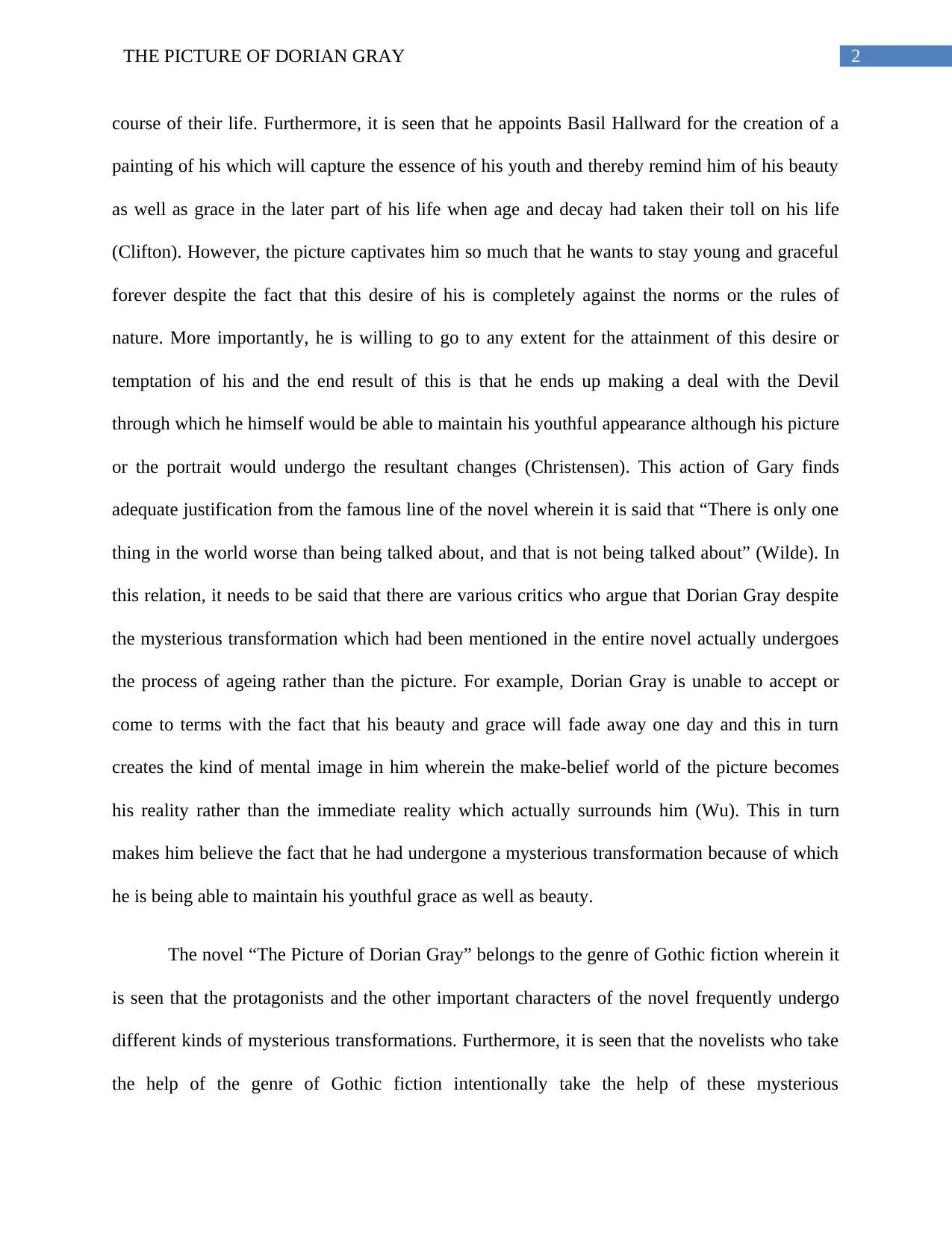
2THE PICTURE OF DORIAN GRAY
course of their life. Furthermore, it is seen that he appoints Basil Hallward for the creation of a
painting of his which will capture the essence of his youth and thereby remind him of his beauty
as well as grace in the later part of his life when age and decay had taken their toll on his life
(Clifton). However, the picture captivates him so much that he wants to stay young and graceful
forever despite the fact that this desire of his is completely against the norms or the rules of
nature. More importantly, he is willing to go to any extent for the attainment of this desire or
temptation of his and the end result of this is that he ends up making a deal with the Devil
through which he himself would be able to maintain his youthful appearance although his picture
or the portrait would undergo the resultant changes (Christensen). This action of Gary finds
adequate justification from the famous line of the novel wherein it is said that “There is only one
thing in the world worse than being talked about, and that is not being talked about” (Wilde). In
this relation, it needs to be said that there are various critics who argue that Dorian Gray despite
the mysterious transformation which had been mentioned in the entire novel actually undergoes
the process of ageing rather than the picture. For example, Dorian Gray is unable to accept or
come to terms with the fact that his beauty and grace will fade away one day and this in turn
creates the kind of mental image in him wherein the make-belief world of the picture becomes
his reality rather than the immediate reality which actually surrounds him (Wu). This in turn
makes him believe the fact that he had undergone a mysterious transformation because of which
he is being able to maintain his youthful grace as well as beauty.
The novel “The Picture of Dorian Gray” belongs to the genre of Gothic fiction wherein it
is seen that the protagonists and the other important characters of the novel frequently undergo
different kinds of mysterious transformations. Furthermore, it is seen that the novelists who take
the help of the genre of Gothic fiction intentionally take the help of these mysterious
course of their life. Furthermore, it is seen that he appoints Basil Hallward for the creation of a
painting of his which will capture the essence of his youth and thereby remind him of his beauty
as well as grace in the later part of his life when age and decay had taken their toll on his life
(Clifton). However, the picture captivates him so much that he wants to stay young and graceful
forever despite the fact that this desire of his is completely against the norms or the rules of
nature. More importantly, he is willing to go to any extent for the attainment of this desire or
temptation of his and the end result of this is that he ends up making a deal with the Devil
through which he himself would be able to maintain his youthful appearance although his picture
or the portrait would undergo the resultant changes (Christensen). This action of Gary finds
adequate justification from the famous line of the novel wherein it is said that “There is only one
thing in the world worse than being talked about, and that is not being talked about” (Wilde). In
this relation, it needs to be said that there are various critics who argue that Dorian Gray despite
the mysterious transformation which had been mentioned in the entire novel actually undergoes
the process of ageing rather than the picture. For example, Dorian Gray is unable to accept or
come to terms with the fact that his beauty and grace will fade away one day and this in turn
creates the kind of mental image in him wherein the make-belief world of the picture becomes
his reality rather than the immediate reality which actually surrounds him (Wu). This in turn
makes him believe the fact that he had undergone a mysterious transformation because of which
he is being able to maintain his youthful grace as well as beauty.
The novel “The Picture of Dorian Gray” belongs to the genre of Gothic fiction wherein it
is seen that the protagonists and the other important characters of the novel frequently undergo
different kinds of mysterious transformations. Furthermore, it is seen that the novelists who take
the help of the genre of Gothic fiction intentionally take the help of these mysterious
⊘ This is a preview!⊘
Do you want full access?
Subscribe today to unlock all pages.

Trusted by 1+ million students worldwide
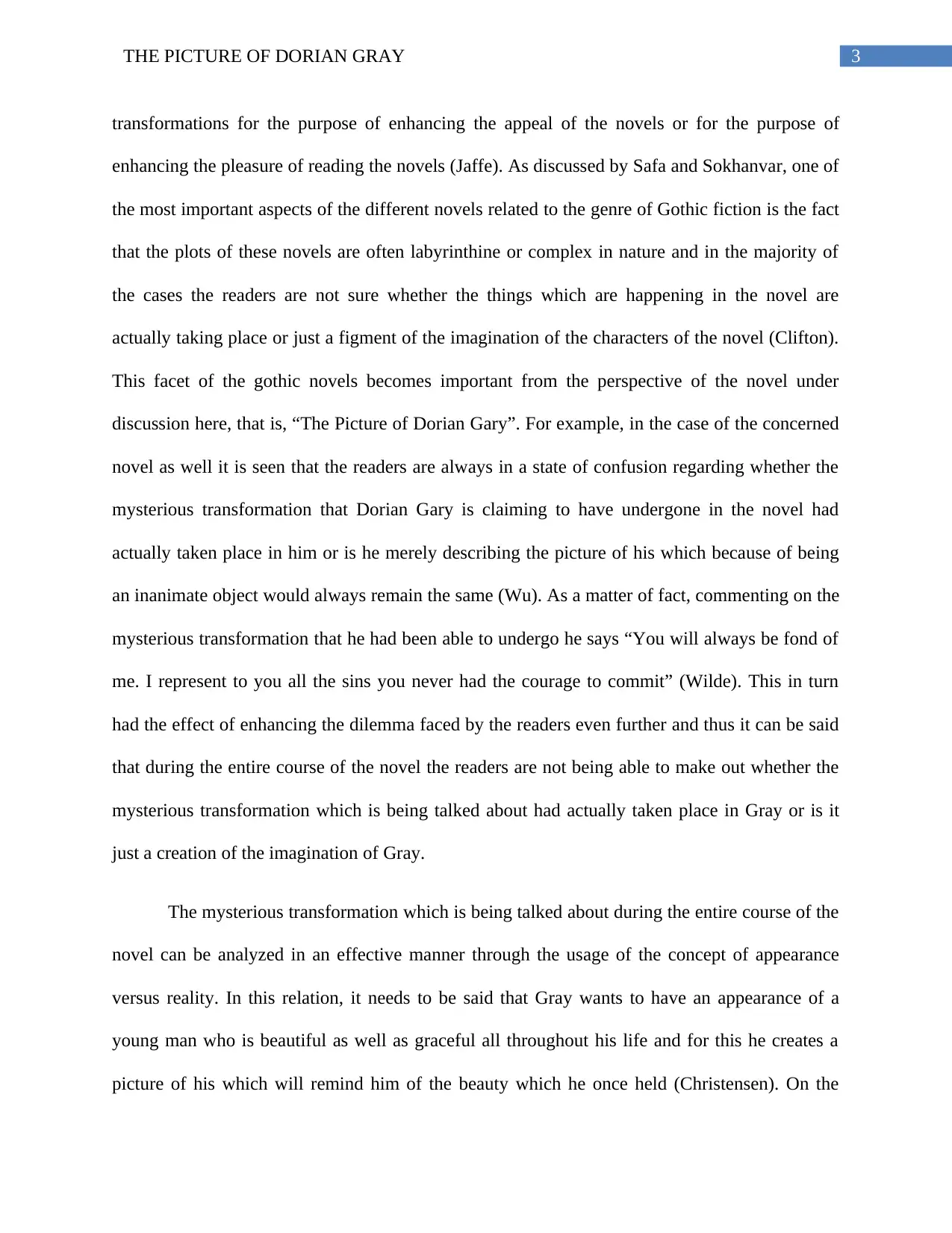
3THE PICTURE OF DORIAN GRAY
transformations for the purpose of enhancing the appeal of the novels or for the purpose of
enhancing the pleasure of reading the novels (Jaffe). As discussed by Safa and Sokhanvar, one of
the most important aspects of the different novels related to the genre of Gothic fiction is the fact
that the plots of these novels are often labyrinthine or complex in nature and in the majority of
the cases the readers are not sure whether the things which are happening in the novel are
actually taking place or just a figment of the imagination of the characters of the novel (Clifton).
This facet of the gothic novels becomes important from the perspective of the novel under
discussion here, that is, “The Picture of Dorian Gary”. For example, in the case of the concerned
novel as well it is seen that the readers are always in a state of confusion regarding whether the
mysterious transformation that Dorian Gary is claiming to have undergone in the novel had
actually taken place in him or is he merely describing the picture of his which because of being
an inanimate object would always remain the same (Wu). As a matter of fact, commenting on the
mysterious transformation that he had been able to undergo he says “You will always be fond of
me. I represent to you all the sins you never had the courage to commit” (Wilde). This in turn
had the effect of enhancing the dilemma faced by the readers even further and thus it can be said
that during the entire course of the novel the readers are not being able to make out whether the
mysterious transformation which is being talked about had actually taken place in Gray or is it
just a creation of the imagination of Gray.
The mysterious transformation which is being talked about during the entire course of the
novel can be analyzed in an effective manner through the usage of the concept of appearance
versus reality. In this relation, it needs to be said that Gray wants to have an appearance of a
young man who is beautiful as well as graceful all throughout his life and for this he creates a
picture of his which will remind him of the beauty which he once held (Christensen). On the
transformations for the purpose of enhancing the appeal of the novels or for the purpose of
enhancing the pleasure of reading the novels (Jaffe). As discussed by Safa and Sokhanvar, one of
the most important aspects of the different novels related to the genre of Gothic fiction is the fact
that the plots of these novels are often labyrinthine or complex in nature and in the majority of
the cases the readers are not sure whether the things which are happening in the novel are
actually taking place or just a figment of the imagination of the characters of the novel (Clifton).
This facet of the gothic novels becomes important from the perspective of the novel under
discussion here, that is, “The Picture of Dorian Gary”. For example, in the case of the concerned
novel as well it is seen that the readers are always in a state of confusion regarding whether the
mysterious transformation that Dorian Gary is claiming to have undergone in the novel had
actually taken place in him or is he merely describing the picture of his which because of being
an inanimate object would always remain the same (Wu). As a matter of fact, commenting on the
mysterious transformation that he had been able to undergo he says “You will always be fond of
me. I represent to you all the sins you never had the courage to commit” (Wilde). This in turn
had the effect of enhancing the dilemma faced by the readers even further and thus it can be said
that during the entire course of the novel the readers are not being able to make out whether the
mysterious transformation which is being talked about had actually taken place in Gray or is it
just a creation of the imagination of Gray.
The mysterious transformation which is being talked about during the entire course of the
novel can be analyzed in an effective manner through the usage of the concept of appearance
versus reality. In this relation, it needs to be said that Gray wants to have an appearance of a
young man who is beautiful as well as graceful all throughout his life and for this he creates a
picture of his which will remind him of the beauty which he once held (Christensen). On the
Paraphrase This Document
Need a fresh take? Get an instant paraphrase of this document with our AI Paraphraser
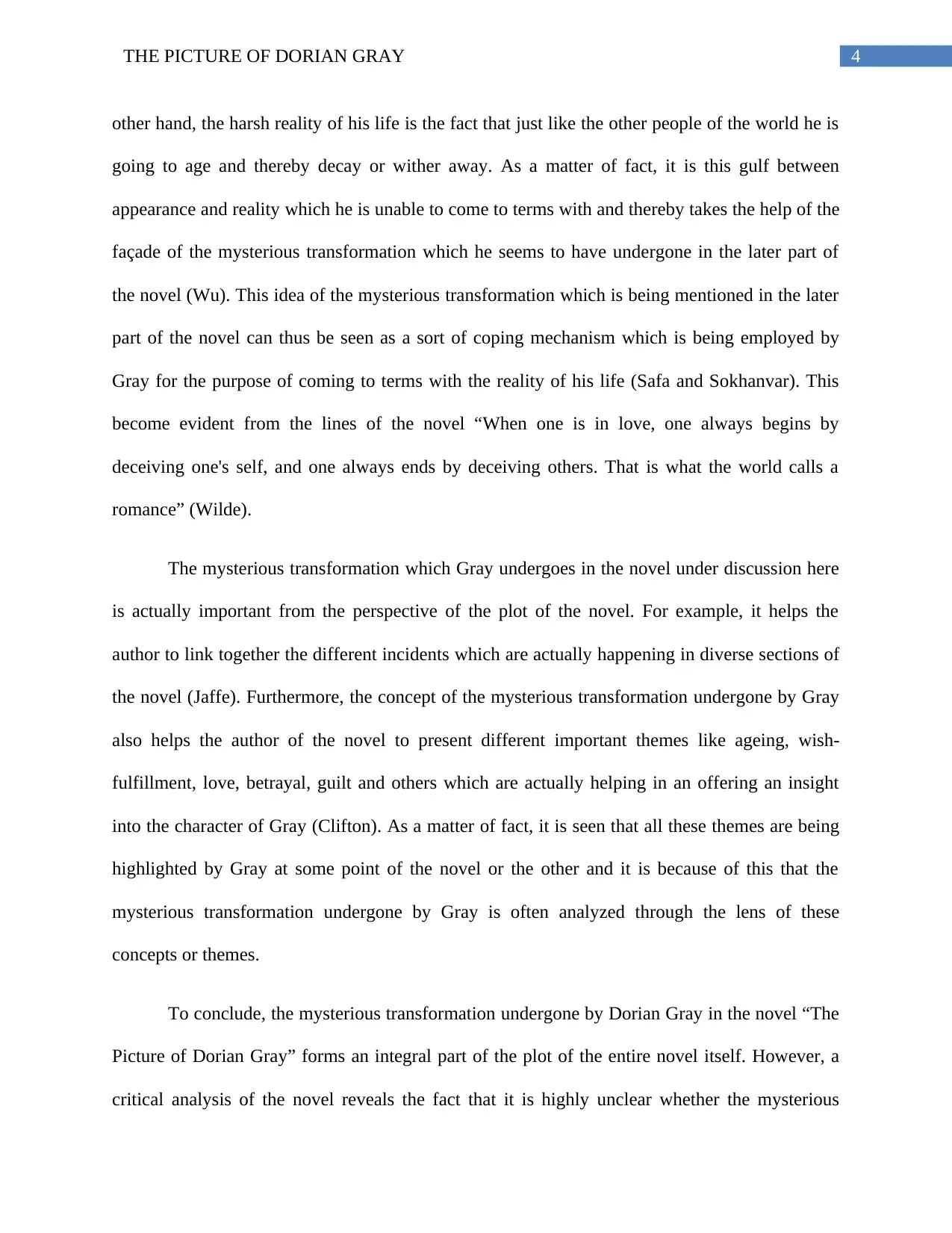
4THE PICTURE OF DORIAN GRAY
other hand, the harsh reality of his life is the fact that just like the other people of the world he is
going to age and thereby decay or wither away. As a matter of fact, it is this gulf between
appearance and reality which he is unable to come to terms with and thereby takes the help of the
façade of the mysterious transformation which he seems to have undergone in the later part of
the novel (Wu). This idea of the mysterious transformation which is being mentioned in the later
part of the novel can thus be seen as a sort of coping mechanism which is being employed by
Gray for the purpose of coming to terms with the reality of his life (Safa and Sokhanvar). This
become evident from the lines of the novel “When one is in love, one always begins by
deceiving one's self, and one always ends by deceiving others. That is what the world calls a
romance” (Wilde).
The mysterious transformation which Gray undergoes in the novel under discussion here
is actually important from the perspective of the plot of the novel. For example, it helps the
author to link together the different incidents which are actually happening in diverse sections of
the novel (Jaffe). Furthermore, the concept of the mysterious transformation undergone by Gray
also helps the author of the novel to present different important themes like ageing, wish-
fulfillment, love, betrayal, guilt and others which are actually helping in an offering an insight
into the character of Gray (Clifton). As a matter of fact, it is seen that all these themes are being
highlighted by Gray at some point of the novel or the other and it is because of this that the
mysterious transformation undergone by Gray is often analyzed through the lens of these
concepts or themes.
To conclude, the mysterious transformation undergone by Dorian Gray in the novel “The
Picture of Dorian Gray” forms an integral part of the plot of the entire novel itself. However, a
critical analysis of the novel reveals the fact that it is highly unclear whether the mysterious
other hand, the harsh reality of his life is the fact that just like the other people of the world he is
going to age and thereby decay or wither away. As a matter of fact, it is this gulf between
appearance and reality which he is unable to come to terms with and thereby takes the help of the
façade of the mysterious transformation which he seems to have undergone in the later part of
the novel (Wu). This idea of the mysterious transformation which is being mentioned in the later
part of the novel can thus be seen as a sort of coping mechanism which is being employed by
Gray for the purpose of coming to terms with the reality of his life (Safa and Sokhanvar). This
become evident from the lines of the novel “When one is in love, one always begins by
deceiving one's self, and one always ends by deceiving others. That is what the world calls a
romance” (Wilde).
The mysterious transformation which Gray undergoes in the novel under discussion here
is actually important from the perspective of the plot of the novel. For example, it helps the
author to link together the different incidents which are actually happening in diverse sections of
the novel (Jaffe). Furthermore, the concept of the mysterious transformation undergone by Gray
also helps the author of the novel to present different important themes like ageing, wish-
fulfillment, love, betrayal, guilt and others which are actually helping in an offering an insight
into the character of Gray (Clifton). As a matter of fact, it is seen that all these themes are being
highlighted by Gray at some point of the novel or the other and it is because of this that the
mysterious transformation undergone by Gray is often analyzed through the lens of these
concepts or themes.
To conclude, the mysterious transformation undergone by Dorian Gray in the novel “The
Picture of Dorian Gray” forms an integral part of the plot of the entire novel itself. However, a
critical analysis of the novel reveals the fact that it is highly unclear whether the mysterious
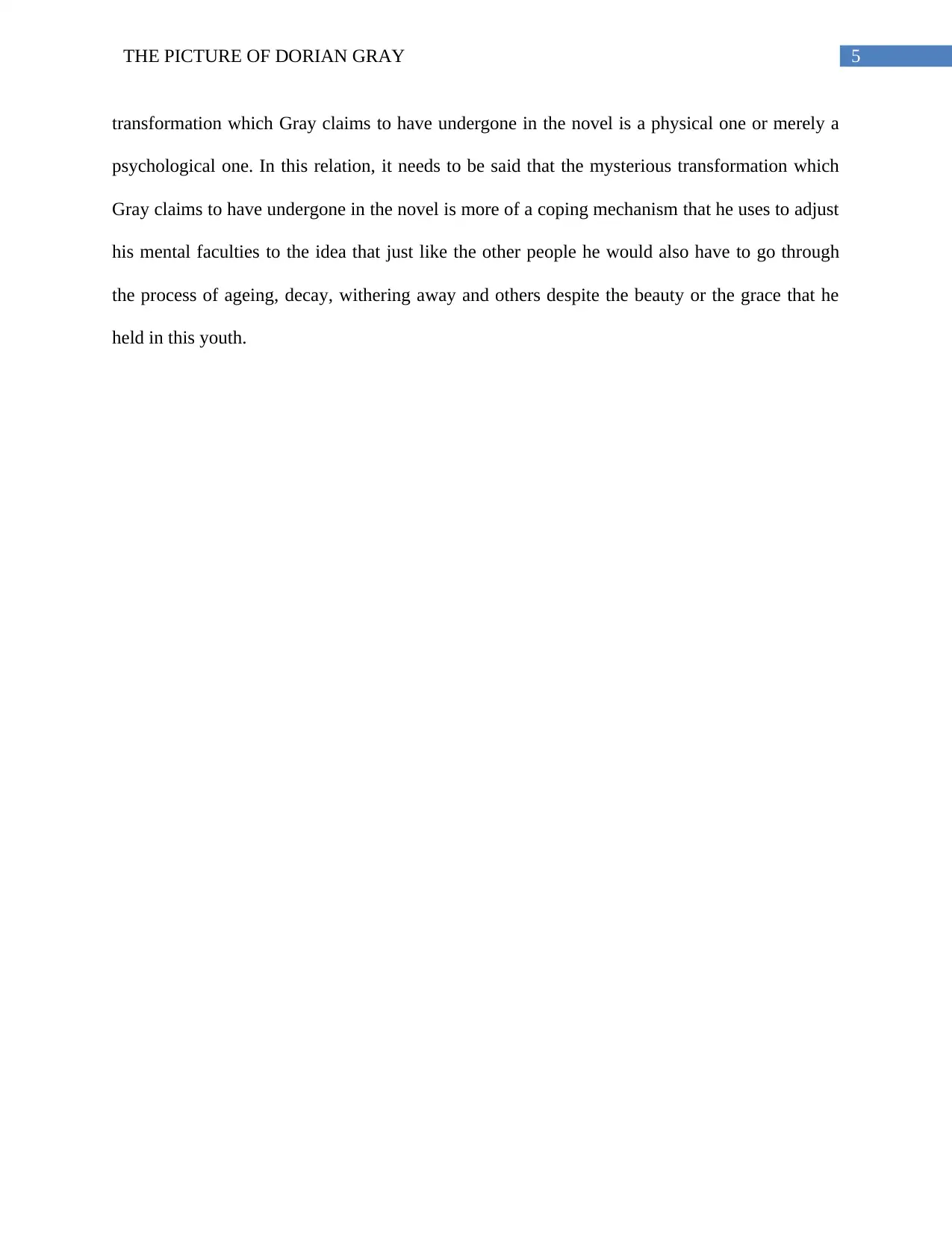
5THE PICTURE OF DORIAN GRAY
transformation which Gray claims to have undergone in the novel is a physical one or merely a
psychological one. In this relation, it needs to be said that the mysterious transformation which
Gray claims to have undergone in the novel is more of a coping mechanism that he uses to adjust
his mental faculties to the idea that just like the other people he would also have to go through
the process of ageing, decay, withering away and others despite the beauty or the grace that he
held in this youth.
transformation which Gray claims to have undergone in the novel is a physical one or merely a
psychological one. In this relation, it needs to be said that the mysterious transformation which
Gray claims to have undergone in the novel is more of a coping mechanism that he uses to adjust
his mental faculties to the idea that just like the other people he would also have to go through
the process of ageing, decay, withering away and others despite the beauty or the grace that he
held in this youth.
⊘ This is a preview!⊘
Do you want full access?
Subscribe today to unlock all pages.

Trusted by 1+ million students worldwide
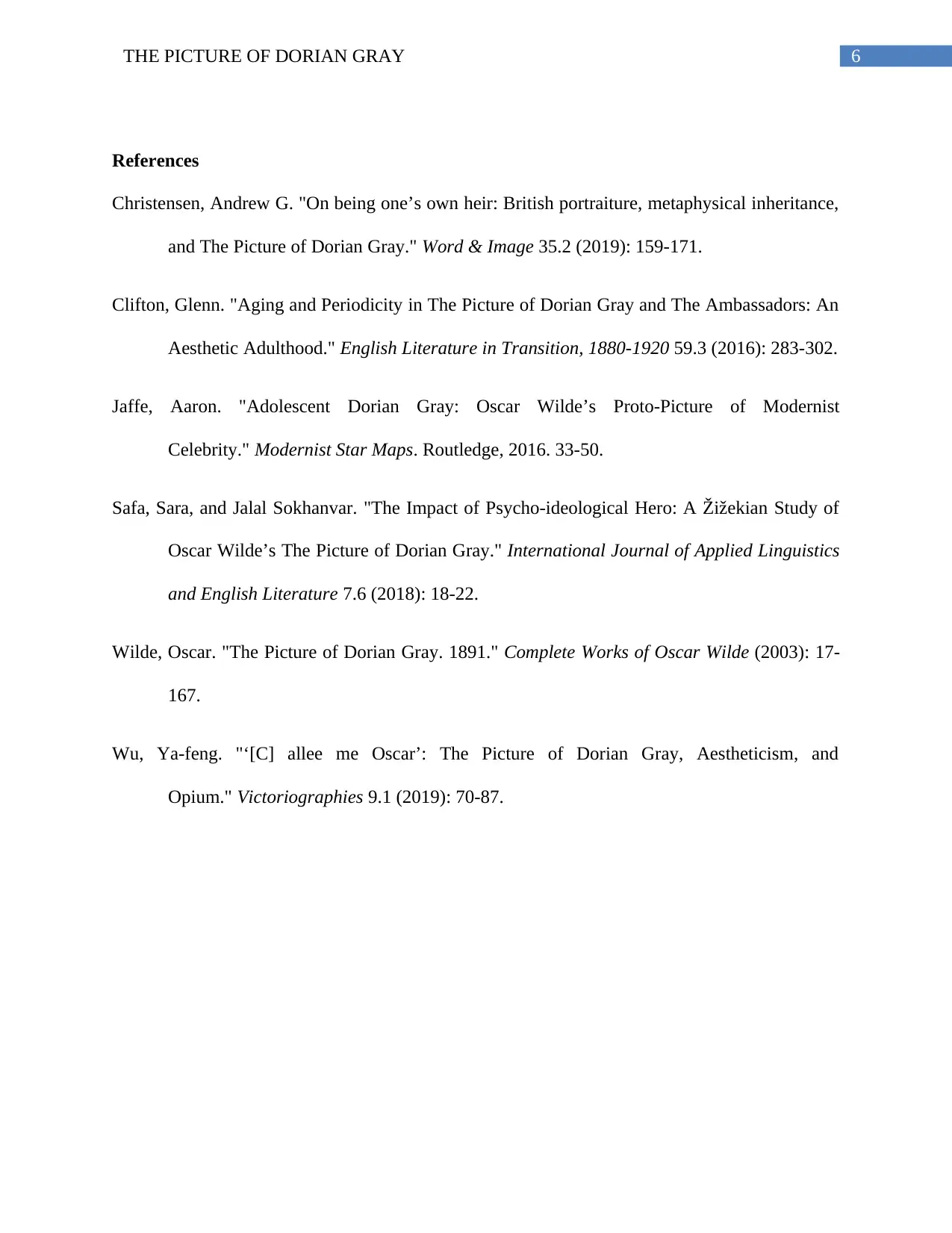
6THE PICTURE OF DORIAN GRAY
References
Christensen, Andrew G. "On being one’s own heir: British portraiture, metaphysical inheritance,
and The Picture of Dorian Gray." Word & Image 35.2 (2019): 159-171.
Clifton, Glenn. "Aging and Periodicity in The Picture of Dorian Gray and The Ambassadors: An
Aesthetic Adulthood." English Literature in Transition, 1880-1920 59.3 (2016): 283-302.
Jaffe, Aaron. "Adolescent Dorian Gray: Oscar Wilde’s Proto-Picture of Modernist
Celebrity." Modernist Star Maps. Routledge, 2016. 33-50.
Safa, Sara, and Jalal Sokhanvar. "The Impact of Psycho-ideological Hero: A Žižekian Study of
Oscar Wilde’s The Picture of Dorian Gray." International Journal of Applied Linguistics
and English Literature 7.6 (2018): 18-22.
Wilde, Oscar. "The Picture of Dorian Gray. 1891." Complete Works of Oscar Wilde (2003): 17-
167.
Wu, Ya-feng. "‘[C] allee me Oscar’: The Picture of Dorian Gray, Aestheticism, and
Opium." Victoriographies 9.1 (2019): 70-87.
References
Christensen, Andrew G. "On being one’s own heir: British portraiture, metaphysical inheritance,
and The Picture of Dorian Gray." Word & Image 35.2 (2019): 159-171.
Clifton, Glenn. "Aging and Periodicity in The Picture of Dorian Gray and The Ambassadors: An
Aesthetic Adulthood." English Literature in Transition, 1880-1920 59.3 (2016): 283-302.
Jaffe, Aaron. "Adolescent Dorian Gray: Oscar Wilde’s Proto-Picture of Modernist
Celebrity." Modernist Star Maps. Routledge, 2016. 33-50.
Safa, Sara, and Jalal Sokhanvar. "The Impact of Psycho-ideological Hero: A Žižekian Study of
Oscar Wilde’s The Picture of Dorian Gray." International Journal of Applied Linguistics
and English Literature 7.6 (2018): 18-22.
Wilde, Oscar. "The Picture of Dorian Gray. 1891." Complete Works of Oscar Wilde (2003): 17-
167.
Wu, Ya-feng. "‘[C] allee me Oscar’: The Picture of Dorian Gray, Aestheticism, and
Opium." Victoriographies 9.1 (2019): 70-87.
1 out of 7
Your All-in-One AI-Powered Toolkit for Academic Success.
+13062052269
info@desklib.com
Available 24*7 on WhatsApp / Email
![[object Object]](/_next/static/media/star-bottom.7253800d.svg)
Unlock your academic potential
Copyright © 2020–2025 A2Z Services. All Rights Reserved. Developed and managed by ZUCOL.


